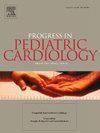Predictors of nonelective removal of peripherally inserted central catheters in children with heart disease
IF 0.8
Q4 PEDIATRICS
引用次数: 0
Abstract
Background
In the pediatric population with heart disease, evidence has assessed the risk factors for all types of access devices. However, there is little evidence to elucidate the predictive factors that cause major complications for nonelective removal of peripherally inserted central catheters (PICC) in this population.
Objective
The purpose of this study was to identify predictors of nonelective removal of PICC in a pediatric population hospitalized for heart disease.
Methods
This was a retrospective cohort study with a sample of 559 PICC lines inserted in 412 neonates, infants, toddlers, children, and adolescents admitted to the tertiary Pediatric Cardiology Unit of a public hospital in northeastern Brazil. We followed the children from insertion until the removal of the PICC. Bivariate analysis and logistic regression were conducted to identify predictors of nonelective removal.
Results
Among the variables investigated that maintained statistical significance for nonelective PICC catheter removal were selection of the external jugular vein, number of venipunctures, noncentral location of the catheter tip, and use of prostaglandin E1(PGE1). The previous central venous catheter insertion was determined as a protective factor for nonelective PICC removal.
Conclusion
External jugular vein selection for insertion, multiple venipuncture attempts, use of PGE1, and noncentral catheter tip position were associated with nonelective removal of the PICC catheter due to complications.
儿童心脏病患者非选择性切除外周中心导管的预测因素
在患有心脏病的儿科人群中,已有证据评估了所有类型的通路装置的危险因素。然而,在这一人群中,几乎没有证据表明导致非选择性外周中心导管(PICC)切除的主要并发症的预测因素。目的本研究的目的是确定因心脏病住院的儿童非选择性PICC切除的预测因素。方法:这是一项回顾性队列研究,在巴西东北部一家公立医院三级儿科心脏病科住院的412名新生儿、婴儿、幼儿、儿童和青少年中插入559个PICC系样本。我们跟踪患儿从插入到取出PICC。进行双变量分析和逻辑回归来确定非选择性切除的预测因素。结果在非选择性PICC导管拔除的变量中,颈外静脉的选择、静脉穿刺次数、导管尖端的非中心位置和前列腺素E1(PGE1)的使用具有统计学意义。先前的中心静脉导管插入被确定为非选择性PICC切除的保护因素。结论选择颈外静脉插入、多次静脉穿刺、PGE1使用和导管尖端位置非中心与PICC导管因并发症而非选择性拔除有关。
本文章由计算机程序翻译,如有差异,请以英文原文为准。
求助全文
约1分钟内获得全文
求助全文
来源期刊

PROGRESS IN PEDIATRIC CARDIOLOGY
PEDIATRICS-
CiteScore
0.90
自引率
11.10%
发文量
69
审稿时长
75 days
期刊介绍:
Progress in Pediatric Cardiology is an international journal of review presenting information and experienced opinion of importance in the understanding and management of cardiovascular diseases in children. Each issue is prepared by one or more Guest Editors and reviews a single subject, allowing for comprehensive presentations of complex, multifaceted or rapidly changing topics of clinical and investigative interest.
 求助内容:
求助内容: 应助结果提醒方式:
应助结果提醒方式:


